![[Updated] In 2024, The Art of Chatting with Voices on WhatsApp](https://thmb.techidaily.com/2759ed3d822d64726b5041a7dfa5154bfc20081c37343fab709d27bf02b2be55.jpg)
[Updated] In 2024, The Art of Chatting with Voices on WhatsApp

The Art of Chatting with Voices on WhatsApp
Hello guys, almost all of us are familiar with the name WhatsApp when it comes to some best and most popular messaging apps. There are numerous features available on WhatsApp. However, today we will discuss an essential topic regarding WhatsApp: how you can send a voice message or recorded audio on WhatsApp. This guide will briefly examine the methods of sending voice messages and audio recording over WhatsApp on iOS or Android.
Part 1. How to send a voice message on WhatsApp?
Now let’s first look into how you can record and send a voice message on WhatsApp. We will discuss it from the perspective of both iOS and Android users.
How to send the voice message on iOS or Android
The steps of recording and sending a voice message using WhatsApp are nearly identical on iOS and Android devices. So both iOS and Android users can follow up on these steps:
- Press and hold the voice recorder button on the right side to record the voice message. However, a more effective way is to swipe up the voice recorder button to lock it. Now you can easily record it without holding the button.
- There are three more options appear at the bottom:
- The Delete button can used to delete the voice you’ve just recorded. However, if you haven’t locked the recorder button, you can delete the message by sliding it to the left.
- The pause button can help you in pausing the recording.
- The send button will send your recorded voice message.
- Before sending, you can also check your recorded voice by clicking the pause button, and then you have the option to play the voice.

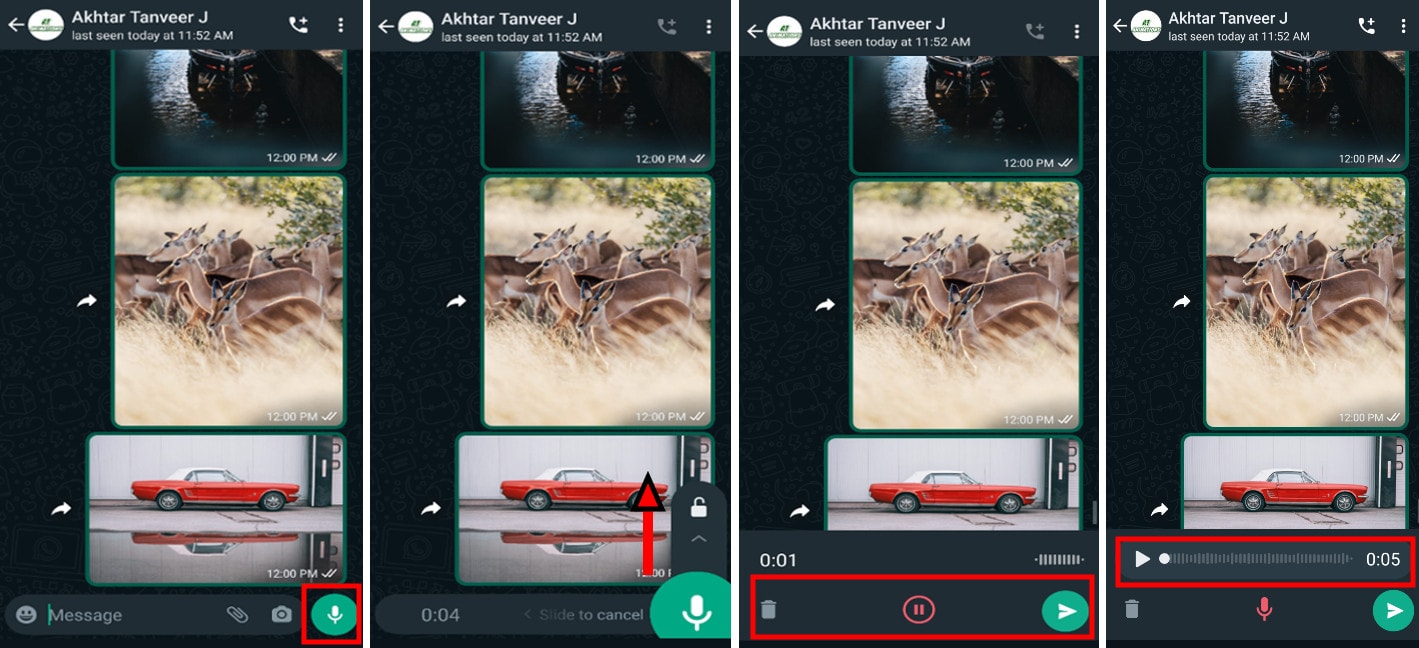
Part 2. How to send recorded audio on WhatsApp?
Until now, we have only discussed how we can record and then send a voice message on WhatsApp, but here is another primary concern: what if you want to send an already recorded audio or voice memo? So, let’s check how we can do this!
Send recorded audio on iOS
We will start with some methods iOS users can use to send their already recorded audio or voice memos on WhatsApp.
Way 1. Share directly to WhatsApp in voice memos:
So, the first method is to share your recorded voice memos over WhatsApp. Just follow the below steps:
- Open your voice memo app on your iPhone and choose the voice you want to send.
- Now click the (…) options button. Then select the share option.
- Choose WhatsApp, and it opens up your contact list. Choose which you want to share and then tap the send button.
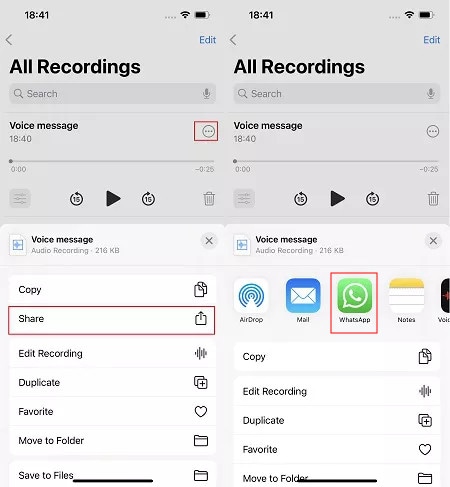
Way 2. Select file sharing in the chat window of WhatsApp:
You can also share the already recorded audio using attach files option in WhatsApp.
- Open WhatsApp chat to which you want to send the audio.
- Click the options button at the left.
- Now select the audio option and then choose the desired audio.
- Click the send button, and it will again ask you to confirm the sending, and once you click the send button again, it will send.
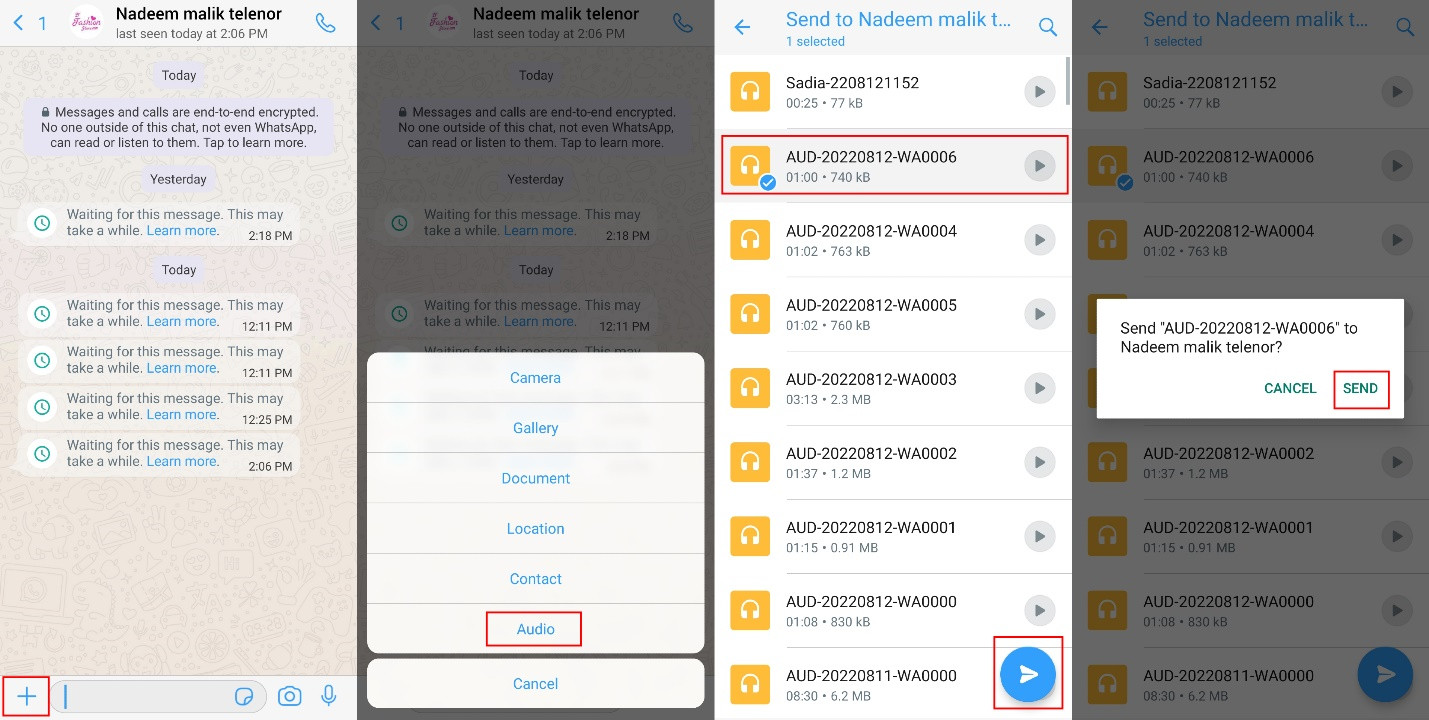
Send recorded audio on Android
To send your recorded audio on Android devices, you can use this method:
Way 1. Select file sharing in the chat window of WhatsApp:
- Open WhatsApp, then choose a chat.
- Tap the file attachment button on the screen’s right side.
- Select the audio option. Now choose the recorded audio you want to send.
- Tap the send option and confirm the sending to send.

Part 3. How to save voice messages on WhatsApp?
The next step is how you can save a WhatsApp voice message. By default, no tools can be available to help you in such a case. However, that doesn’t mean you can never save a WhatsApp voice recording. Still, there are multiple ways you can do it. We are going to discuss a few best practices in this regard.
Save voice notes on iOS
There are the methods that only iOS users can use:
Way 1. Using iCloud Backup:
You can use iCloud to save voice notes on WhatsApp. This is one of the most reliable and convenient ways to save your voice records on WhatsApp on your iPhone.
- Open the settings of your iPhone.
- Now select the iCloud tab. You have to turn it on and sign up/ login into your account.
- Once you’ve completed with above, scroll down the options under iCloud and turn the WhatsApp option on.
- From now it will save you all WhatsApp data, including voice messages.
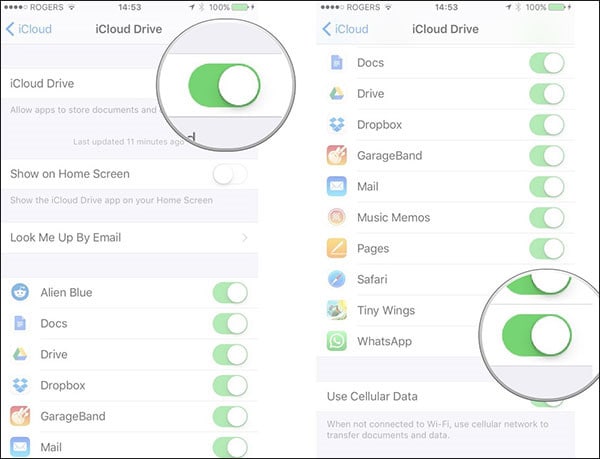
Way 2. Use Screen Recording:
This is another way to get your voice messages stored.
- Download iOS Screen Recorder .
- Now open settings and then select the general tab. Under it, click the device management button and tap the distributor name. Turn on the trust option to grant access.
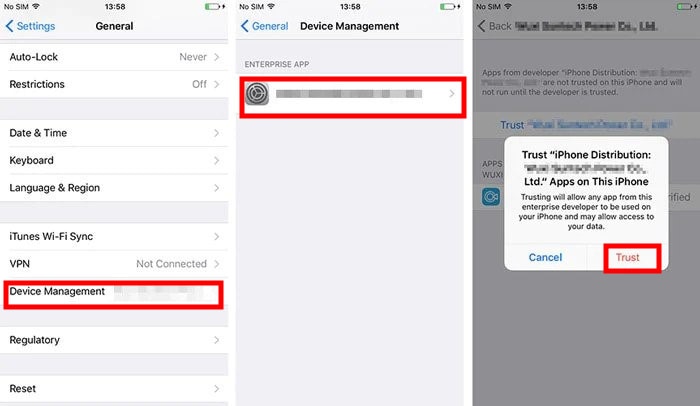
- Open the iOS Screen Recorder App. Before starting recording, it will show some options. Under audio, select the internal audio.
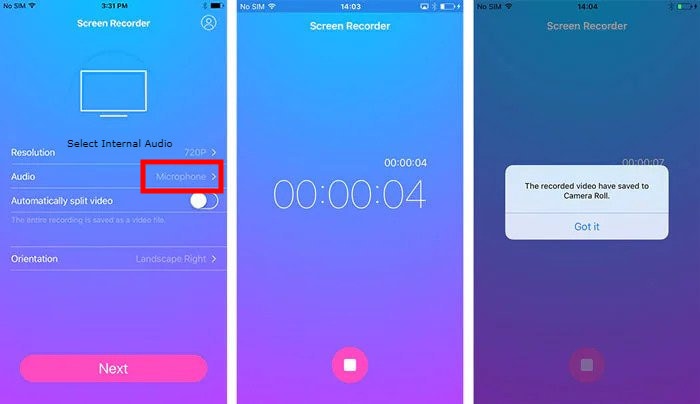
- Now play any audio clip and record it to save.
Save voice notes on Android
It’s now time to discuss the details for Android users. These are a few effective ways Android users can use to save their voice messages on WhatsApp.
Way 1. Find voice messages files on File Manager:
In Android, you have access to the file manager. So, it’s very much easy to save voice notes on WhatsApp. Once you’ve downloaded them, follow these steps:
- Open the File Manager of your device.
- Now choose the internal storage.
- Then click the Android folder.
- Tap the media folder and then choose whatsapp folder
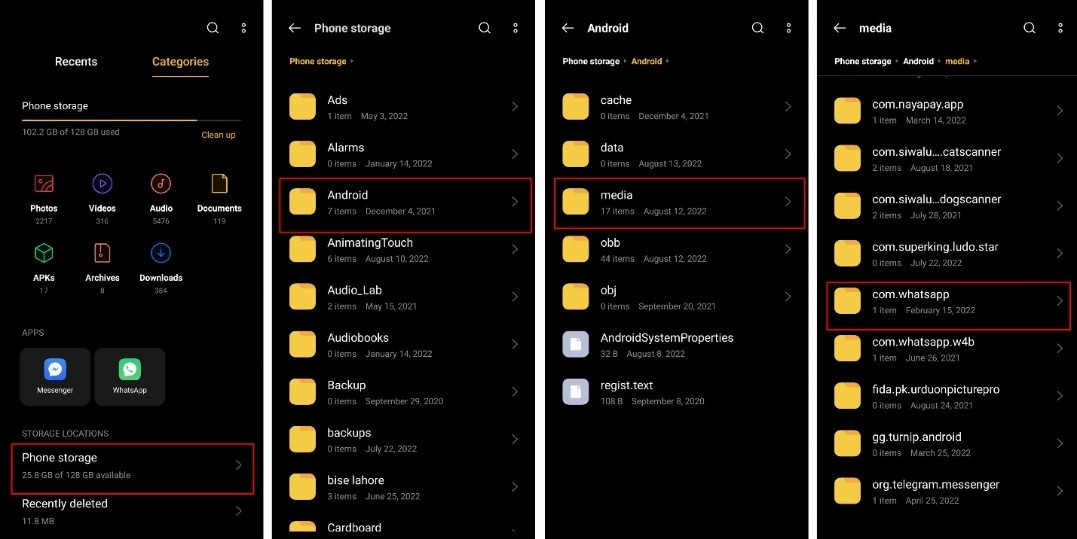
- Now open the WhatsApp folder and choose Media under it.
- Click the WhatsApp Audio. Now all your voice messages are shown here, including sent and received.
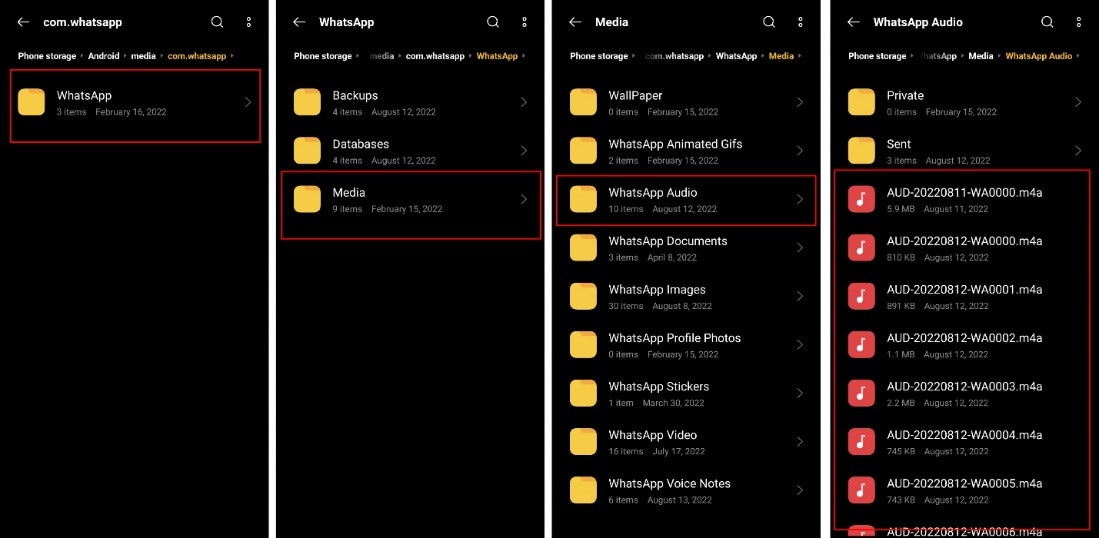
Way 2. Use screen Recording:
You can also record voice messages on WhatsApp using a screen recorder on Android.
- Download the Screen Recorder for Android.
- Open the app and provide the required access.
- Before recording, open the settings tab and select internal audio under the audio option.
- Run the screen recorder and then play your voice messages to record.
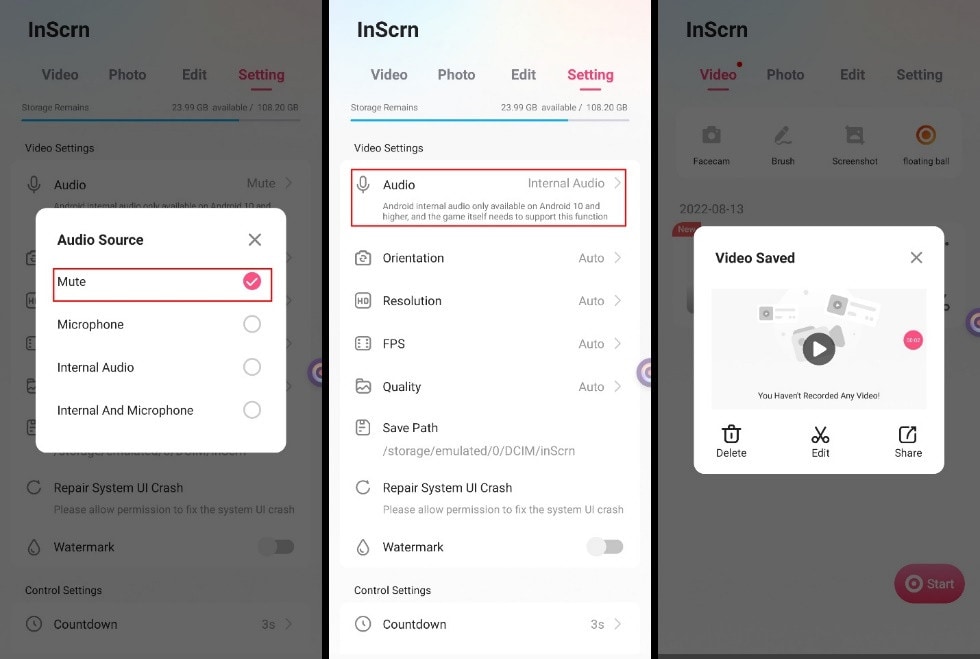
Save voice notes on iOS / Android
Way 1. Use email to forward
This method is an identical for both iPhone and Android users. It will help you if you want to save only selected voice messages on WhatsApp. It’s the easiest way to make it done. All you have to do is:
- Choose the WhatsApp voice message you want to save.
- Long press it and then click the options button at the top.
- Select the share option and then choose the email.
- You can forward it to yourself or any other email.
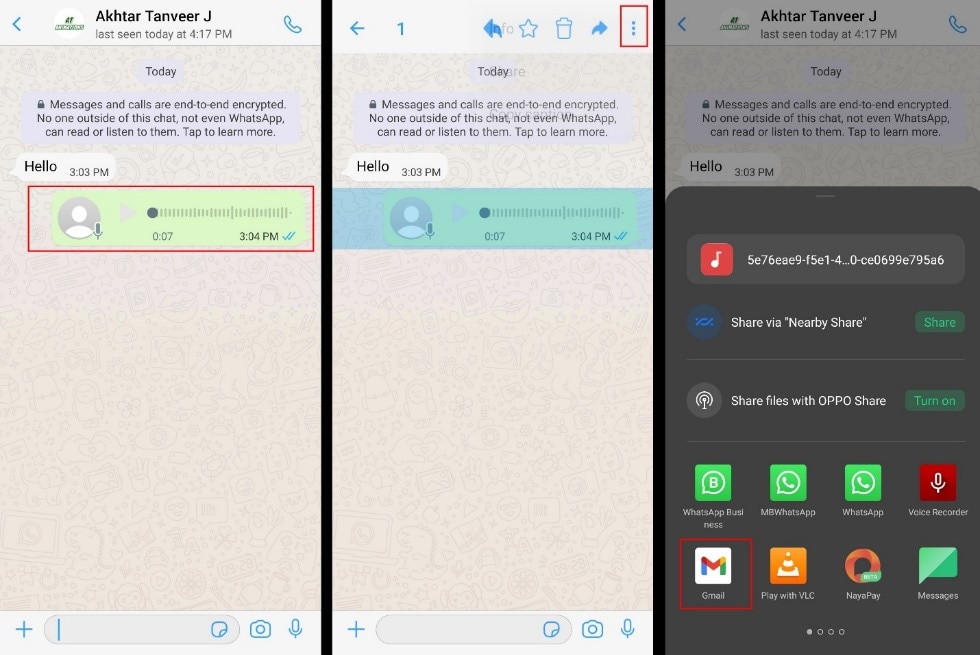
Way 2. Forward Messages
This is another method that’s nearly the same on Android and iOS. This will be best for you if you don’t want to do such massive practices. All you have to do is to make a New WhatsApp Group and forward all your voice messages there.
- Make a new WhatsApp Group with any one member.
- After you’ve created the group, remove the other person.
- Forward the voice messages you want to save to the group.

Conclusion
The conclusion is that WhatsApp offers a variety of great features. You can easily record and send voice messages or even send already recorded audio on WhatsApp. When it comes to saving a voice message, then there is no default way available. But, there are also multiple ways to complete it. So, in this article, we have discussed many techniques and methods to achieve a single goal in detail. However, you can use the one that best fits your requirement and goals. Thanks for reading.
Free Download For Win 7 or later(64-bit)
Free Download For macOS 10.14 or later
Free Download For macOS 10.14 or later
- Title: [Updated] In 2024, The Art of Chatting with Voices on WhatsApp
- Author: Jeffrey
- Created at : 2024-07-12 02:00:27
- Updated at : 2024-07-13 02:00:27
- Link: https://fox-hovers.techidaily.com/updated-in-2024-the-art-of-chatting-with-voices-on-whatsapp/
- License: This work is licensed under CC BY-NC-SA 4.0.